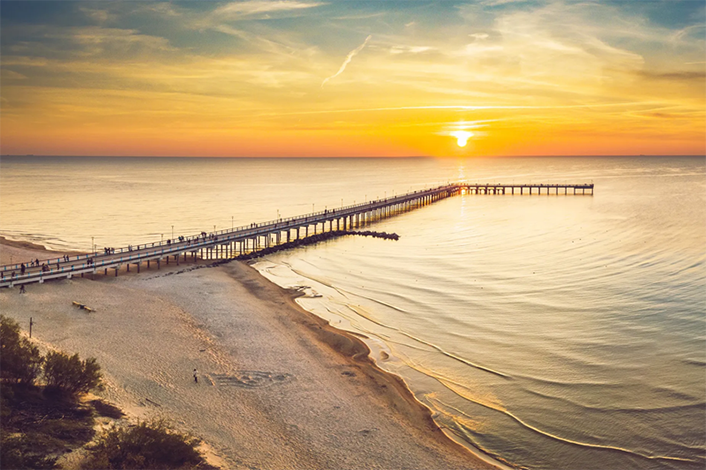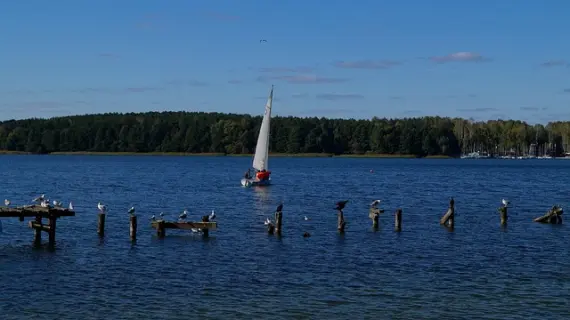PALANGA bus to OLSZTYN
PALANGA

Palanga is one of Lithuania's most popular seaside resorts, located on the Baltic Sea. It is famous for its beautiful sandy beaches and bustling Basanavičiaus promenade, full of restaurants, cafes and souvenir stores.
One of the city's main attractions is the Tyszkiewicz Palace, which houses the Amber Museum, displaying unique exhibits of this "Baltic gold." Surrounding the palace is the picturesque Botanical Park, ideal for strolling and relaxing.
There is also a pier in Palanga, which is a popular place for strolling and admiring sunsets. Outdoor enthusiasts can take a bike ride along the coastal trails or visit the Sculpture Garden, featuring works by Lithuanian artists.
Every year, Palanga hosts many cultural events, such as the Amber Festival and Palangos Stintų Šventė, a festival dedicated to traditional fishing and fish tasting. In summer, the city attracts tourists with concerts and outdoor festivals.
With its combination of coastal climate, beautiful nature and rich cultural offerings, Palanga is an ideal place for summer rest and relaxation.
Palanga is one of Lithuania's most popular seaside resorts, located on the Baltic Sea. It is famous for its beautiful sandy beaches and bustling Basanavičiaus promenade, full of restaurants, cafes and souvenir stores.
One of the city's main attractions is the Tyszkiewicz Palace, which houses the Amber Museum, displaying unique exhibits of this "Baltic gold." Surrounding the palace is the picturesque Botanical Park, ideal for strolling and relaxing.
There is also a pier in Palanga, which is a popular place for strolling and admiring sunsets. Outdoor enthusiasts can take a bike ride along the coastal trails or visit the Sculpture Garden, featuring works by Lithuanian artists.
Every year, Palanga hosts many cultural events, such as the Amber Festival and Palangos Stintų Šventė, a festival dedicated to traditional fishing and fish tasting. In summer, the city attracts tourists with concerts and outdoor festivals.
With its combination of coastal climate, beautiful nature and rich cultural offerings, Palanga is an ideal place for summer rest and relaxation.
OLSZTYN

Olsztyn is the capital of the Warmian-Masurian Voivodeship and the largest city in Warmia, with a population of over 170,000. The city lies on the Lyna River. What is worth seeing in this green and lake-surrounded city of Copernicus, Prussian babes and marzipan?
Most noteworthy is the Castle of the Warmian Chapter from the mid-14th century, in the courtyard of which you can see the mysterious early medieval Prussian baba. Years ago, Nicolaus Copernicus lived there. Another important object on the map of Olsztyn is the counter-cathedral basilica of St. James the Apostle from the second half of the 14th century.
It is also worth taking a stroll through Olsztyn's Old Town and seeing the High Gate, the only surviving medieval city gate. There is also an interesting Museum of Modernity, the BWA Art Gallery presenting Polish and foreign contemporary art, as well as a planetarium and an astronomical observatory. Olsztyn is surrounded by forests and lakes of the Olsztyn Lake District, and in the city itself the Central Park and Janusz Kusociński Park are a green oasis.
Olsztyn - by bus, train or car?
Olsztyn is located in the central part of the Warmian-Masurian province. National and provincial roads pass through it. The city also has a ring road. Olsztyn's main train station and bus station are located at Konstytucji 3 Maja Square, a short distance from Olsztyn's Old Town.
If you plan to visit Olsztyn, the bus will be a great choice. Use the search engine on the homepage and find the right connection for you to the capital of Warmia.
Olsztyn is the capital of the Warmian-Masurian Voivodeship and the largest city in Warmia, with a population of over 170,000. The city lies on the Lyna River. What is worth seeing in this green and lake-surrounded city of Copernicus, Prussian babes and marzipan?
Most noteworthy is the Castle of the Warmian Chapter from the mid-14th century, in the courtyard of which you can see the mysterious early medieval Prussian baba. Years ago, Nicolaus Copernicus lived there. Another important object on the map of Olsztyn is the counter-cathedral basilica of St. James the Apostle from the second half of the 14th century.
It is also worth taking a stroll through Olsztyn's Old Town and seeing the High Gate, the only surviving medieval city gate. There is also an interesting Museum of Modernity, the BWA Art Gallery presenting Polish and foreign contemporary art, as well as a planetarium and an astronomical observatory. Olsztyn is surrounded by forests and lakes of the Olsztyn Lake District, and in the city itself the Central Park and Janusz Kusociński Park are a green oasis.
Olsztyn - by bus, train or car?
Olsztyn is located in the central part of the Warmian-Masurian province. National and provincial roads pass through it. The city also has a ring road. Olsztyn's main train station and bus station are located at Konstytucji 3 Maja Square, a short distance from Olsztyn's Old Town.
If you plan to visit Olsztyn, the bus will be a great choice. Use the search engine on the homepage and find the right connection for you to the capital of Warmia.
© 2025 Sindbad
Technical support, assistance, payments: Sindbad IT
© 2025 Sindbad
Technical support, assistance, payments: Sindbad IT
